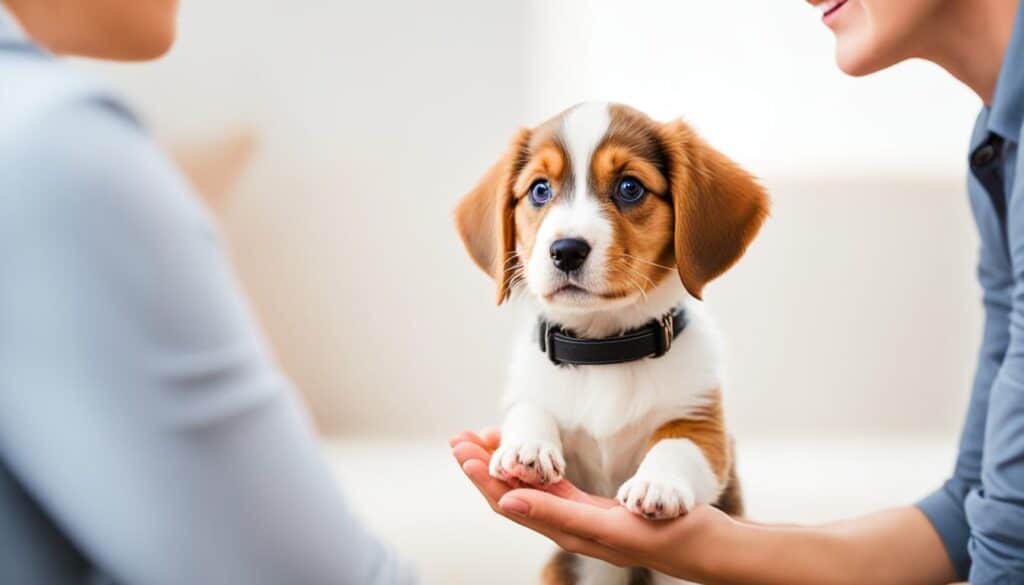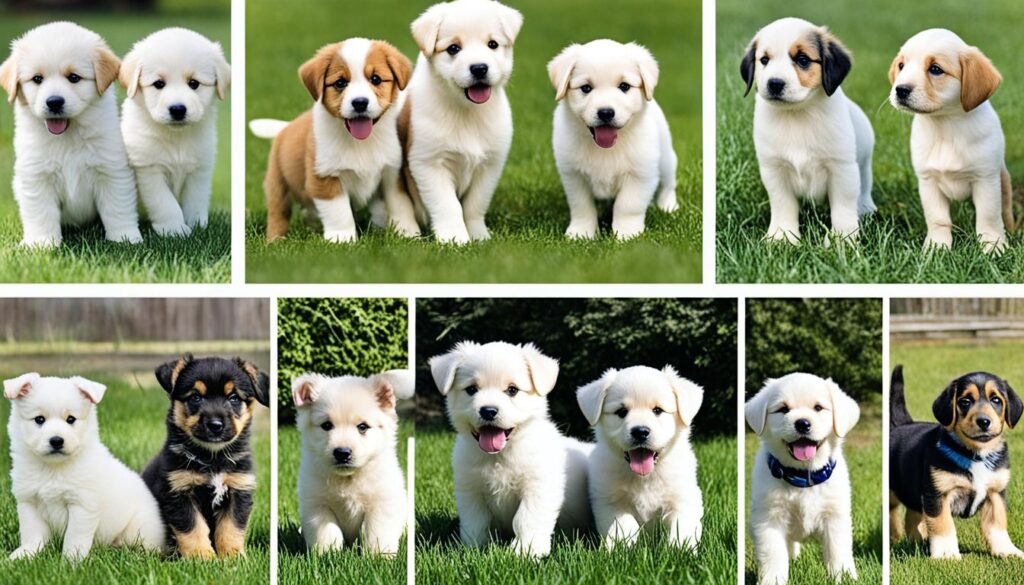The Art of Communicating with Your Puppy: Advanced Techniques
Effective communication is the cornerstone of building a strong bond with your furry friend. As a responsible pet owner, you must go beyond basic commands and truly understand your puppy’s needs, emotions, and desires. This article will explore advanced techniques for communicating with your puppy, taking your connection to new heights.
From deciphering their body language to understanding vocalizations, we’ll delve into the intricacies of puppy communication. We’ll also provide insights on enhancing your communication skills to ensure a seamless and rewarding interaction with your pet. So, let’s embark on this journey of discovery, uncovering the art of communicating with your puppy through advanced techniques.

Key Takeaways:
- Effective communication strengthens the bond between you and your puppy.
- Understanding canine body language is crucial for meaningful communication.
- Vocalizations and their meanings provide essential insights into your puppy’s emotions.
- Mastering your communication skills is fundamental for successful interaction.
- Avoiding common communication mishaps ensures clarity and understanding.
Recognizing the Nuances of Canine Body Language
To effectively communicate with your puppy, it’s essential to understand the intricacies of their body language. Canines express themselves uniquely through various physical cues, including tail wags, ear positions, eye contact, and posture. Pet owners can gain valuable insights into their puppy’s emotions and needs by interpreting these signals.
The Power of the Tail
Wagging a dog’s tail is often seen as a universal sign of happiness, but it’s essential to recognize that tail wags can have different meanings. The wag’s position, speed, and direction can convey a range of emotions, including excitement, friendliness, nervousness, or even aggression. Attention to these subtle variations can provide valuable clues about your puppy’s mind.
Ears Tell a Story
Like the tail, a dog’s ears can reveal much about their emotions. When the ears are alert and perked up, it usually indicates attentiveness or curiosity. Conversely, relaxed and folded-back ears often signify relaxation or contentment. Different ear positions can correspond to emotions such as fear, aggression, or playfulness. You can better understand your puppy’s emotional state by understanding these signals.
Eye Contact and What it Means
Eye contact is an essential form of communication among dogs and between dogs and humans. A direct gaze demonstrates confidence and assertiveness, while averting eye contact can signal submission or fear. Blinking can be a calming signal, indicating a desire to diffuse tension. By paying attention to your puppy’s eye contact, you can gauge their comfort level and adjust your approach accordingly.
The Language of Posture
Canine posture speaks volumes about their intentions and emotions. A playful bow, where the front legs are lowered and the rear is raised, is a classic invitation to play. On the other hand, a cowering posture may indicate fear or submissiveness. Dominance displays, such as standing tall with the chest out, can convey confidence or a desire to establish control. Recognizing these different postures can help you understand your puppy’s behavior and respond appropriately.

Understanding and interpreting canine body language is crucial for any pet owner. You can better communicate with your puppy and strengthen your relationship by paying attention to tail wags, ear positions, eye contact, and posture. Next, we’ll explore the significance of deciphering your puppy’s vocalizations, helping you understand their needs and desires more deeply.
Deciphering Your Puppy’s Vocalizations
In addition to body language, puppies use vocalizations as a critical form of communication. Understanding and interpreting their vocal cues can help pet owners better meet their puppies’ needs and strengthen their bond. This section will explore puppies’ different vocalizations and shed light on their meanings.
It’s Not Just Barking – Whines, Howls, Growls
Puppies use various vocalizations to express their emotions and communicate specific messages. Whining, for example, is often associated with seeking attention, anxiety, or expressing physical discomfort. On the other hand, howling is a form of vocal communication that can indicate loneliness or a response to certain stimuli. Although commonly perceived as a sign of aggression, growling can also be a way for puppies to express fear, protectiveness, or assert their boundaries.
Differences in Barking
Barking is a versatile vocalization with different meanings depending on the context. Playful barking is often accompanied by a wagging tail and relaxed body language, while alert barking is a response to a potential threat or something out of the ordinary. Fearful barking, characterized by a high-pitched tone and a crouched posture, expresses anxiety or unease. Finally, demanding barking is a way for puppies to communicate their needs, such as requesting food or attention.
Understanding Whimpers and Whimpering
Whimpers and whimpering are softer vocalizations that puppies use to convey specific messages. Whimpers can indicate pain or discomfort and a plea for attention or help. Whimpering, often accompanied by trembling or pacing, is frequently associated with anxiety or fear. Understanding these vocal cues can help pet owners identify situations where their puppies need immediate assistance or reassurance.

Mastering Your Communication: Advanced Techniques
To effectively communicate with your puppy, it’s essential to master the art of advanced communication techniques. Consistency in training, timing in training, positive reinforcement, and shaping behaviors are crucial components that can enhance communication and strengthen your bond with your furry friend.
Consistency is King
When training your puppy, using consistent words and cues is crucial. Using the same commands repeatedly, you help your puppy associate specific actions with certain words or cues. This will aid in their understanding and response to your commands over time.
The Importance of Timing in Training
Timing is everything when it comes to training your puppy. It’s important to reinforce good behaviors instantly by providing immediate praise or rewards. This helps your puppy understand which behaviors are desirable and increases the likelihood of them repeating them.
Positive Reinforcement is Not Just Treats
Positive reinforcement is a powerful tool in training your puppy. While treats can be effective, other forms of positive reinforcement, such as praise, play, and affection, are also essential. These rewards will make the training experience more enjoyable for your puppy and strengthen your bond with them.
Beyond ‘Sit’ and ‘Stay:’ Shaping Behaviors
Shaping behaviors involves capturing and rewarding your puppy’s actions, which are steps towards the desired behavior. Instead of waiting for your puppy to perform the complete behavior, you break it down into smaller, achievable steps. You gradually shape their behavior towards the desired outcome by rewarding each step. This technique encourages your puppy to participate and learn new behaviors actively.
| Advanced Communication Techniques | Benefits |
| Consistency in training | Helps your puppy understand and respond to commands more effectively |
| Timing in training | Reinforces good behaviors instantly, improving training results |
| Positive reinforcement | Makes training enjoyable and deepens the bond with your puppy |
| Shaping behaviors | Encourages active learning and helps your puppy acquire new skills |
Common Communication Mishaps and How to Avoid Them
Effective communication is crucial for building a strong bond with your furry friend. However, there are common communication mishaps that pet owners may need to be made aware of, leading to puppy misunderstandings and frustration. In this section, we will discuss these mishaps and provide helpful tips on how to avoid them, ensuring clear and effective communication with your puppy.
When Your Pup Misunderstands You
One common communication mishap is when your puppy needs to understand your cues. It’s vital to re-evaluate your communication methods to ensure clarity and understanding. Step back and assess how you convey your messages to your pup. Are your cues consistent? Are you using clear and concise commands? You can avoid confusion and enhance communication with your puppy by ensuring that your cues are consistent and clear to understand.
Mixed Signals: Are You Confusing Your Puppy?
Another communication mishap pet owners may encounter is sending mixed signals to their puppies. This often occurs when family members have varying communication styles or use other commands for the same actions. Establishing family-wide consistency in communication is essential to avoid confusing your puppy. Ensure everyone is on the same page and uses consistent cues and commands. This will provide your puppy with clarity and help them understand what is expected of them.
When Frustration Sets In
Frustration in communication can arise when we feel that our messages are not getting through to our puppies. Recognizing when frustration sets in is crucial, and taking a break to avoid negative associations is vital. When you start feeling frustrated, your body language and tone of voice may inadvertently convey frustration to your puppy, leading to further miscommunication. Taking a short break and regaining your composure can ensure a calmer and more effective communication session with your furry friend.
| Communication Mishap | Tips to Avoid |
| Misunderstanding cues | – Ensure clear and consistent cues- Evaluate your communication clarity |
| Mixed signals | – Establish family-wide consistency- Use consistent cues and commands |
| Frustration in communication | – Take a break to avoid negative associations- Regain composure before continuing |
Deepening the Bond: Emotional Communication
Puppies, like humans, have emotional needs that play a crucial role in strengthening the bond between them and their owners. Recognizing and fulfilling these needs is an essential aspect of effective communication. One of the critical emotional needs of puppies is security. They crave a sense of safety and depend on their owners to provide it. Creating a consistent and structured environment, without potential threats, helps establish trust and strengthens the emotional connection between pet and owner.
Another essential emotional need is play. Puppies are naturally playful creatures, and engaging in interactive play sessions with them not only fosters physical development but also promotes emotional well-being. It’s an opportunity for them to bond with their owners, release excess energy, and experience joy. Incorporating play into daily routines is a beautiful way to establish a deeper emotional connection.
Conclusion
Expressing love and reassurance is vital to emotional communication with puppies. A gentle touch and a soothing voice can work wonders in making a puppy feel secure and loved. Petting your puppy, giving them belly rubs or cuddles, and speaking calmly and reassuringly can convey affection and strengthen the bond between you. These gestures help puppies understand that they are valued and cherished family members.
Lastly, showing empathetic responses is crucial when your puppy experiences fear or anxiety. A calm demeanor and creating a safe space for them can provide reassurance and help alleviate their distress. When your puppy feels scared or anxious, being patient, understanding, and supportive is essential. Whether through a cozy den or simply being present, offering comfort can significantly enhance the emotional connection and build trust between you and your pup.

